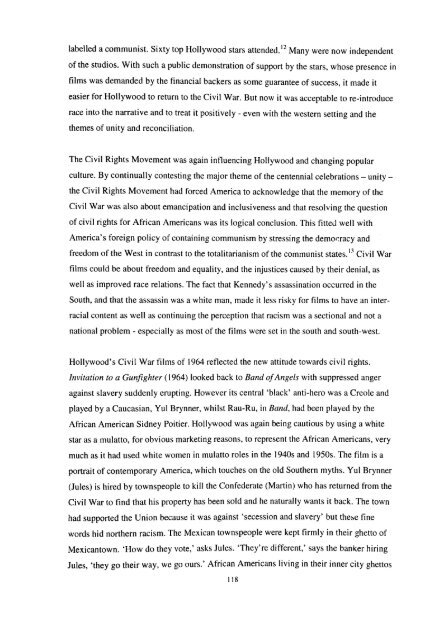Download (3483kB) - Greenwich Academic Literature Archive ...
Download (3483kB) - Greenwich Academic Literature Archive ...
Download (3483kB) - Greenwich Academic Literature Archive ...
- No tags were found...
You also want an ePaper? Increase the reach of your titles
YUMPU automatically turns print PDFs into web optimized ePapers that Google loves.
labelled a communist. Sixty top Hollywood stars attended. 12 Many were now independentof the studios. With such a public demonstration of support by the stars, whose presence infilms was demanded by the financial backers as some guarantee of success, it made iteasier for Hollywood to return to the Civil War. But now it was acceptable to re-introducerace into the narrative and to treat it positively - even with the western setting and thethemes of unity and reconciliation.The Civil Rights Movement was again influencing Hollywood and changing popularculture. By continually contesting the major theme of the centennial celebrations - unity -the Civil Rights Movement had forced America to acknowledge that the memory of theCivil War was also about emancipation and inclusiveness and that resolving the questionof civil rights for African Americans was its logical conclusion. This fitted well withAmerica's foreign policy of containing communism by stressing the democracy andfreedom of the West in contrast to the totalitarianism of the communist states. 13 Civil Warfilms could be about freedom and equality, and the injustices caused by their denial, aswell as improved race relations. The fact that Kennedy's assassination occurred in theSouth, and that the assassin was a white man, made it less risky for films to have an inter-racial content as well as continuing the perception that racism was a sectional and not anational problem - especially as most of the films were set in the south and south-west.Hollywood's Civil War films of 1964 reflected the new attitude towards civil rights.Invitation to a Gunfighter ( 1964) looked back to Ban d of Angels with suppressed angeragainst slavery suddenly erupting. However its central 'black' anti-hero was a Creole andplayed by a Caucasian, Yul Brynner, whilst Rau-Ru, in Band, had been played by theAfrican American Sidney Poitier. Hollywood was again being cautious by using a whitestar as a mulatto, for obvious marketing reasons, to represent the African Americans, verymuch as it had used white women in mulatto roles in the 1940s and 1950s. The film is aportrait of contemporary America, which touches on the old Southern myths. Yul Brynner(Jules) is hired by townspeople to kill the Confederate (Martin) who has returned from theCivil War to find that his property has been sold and he naturally wants it back. The townhad supported the Union because it was against 'secession and slavery' but the^e finewords hid northern racism. The Mexican townspeople were kept firmly in their ghetto ofMexicantown. 'How do they vote,' asks Jules. They're different,' says the banker hiringJules, 'they go their way, we go ours.' African Americans living in their inner city ghettos118
















